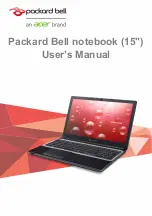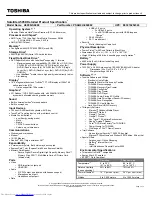
Appendix H - Glossary
163
PCI
Peripheral Connect Interface, this is the successor of ISA
bus, it provides a much faster speed than ISA. The speed on
the bus is 33MHz.
PCMCIA
Personal Computer Memory Card International Association
cards (pronounced as separate letters). Also known as PC
cards. Credit card sized devices that conform to the
standards of this association. There are three types of
PCMCIA cards. All three have the same rectangular size
(85.6 by 54 millimeters), but different widths. Type I cards can
be up to 3.3 mm thick, and are used primarily for adding
additional ROM or RAM to a computer. Type II cards can be
up to 5.5 mm thick. These cards are often used for modem
and fax modem cards. Type III cards can be up to 10.5 mm
thick, which is sufficiently large for portable disk drives. As
with the cards, PCMCIA slots also come in three sizes: a
Type I slot can hold one Type I card, a Type II slot can hold
one Type II card or two Type I cards, a Type III slot can hold
one Type III card or a Type I and Type II card.
Peripheral
Any device that is connected to the computer system (i.e.,
printers, keyboard, plotters, port-replicator, etc.).
Pixel
Image elements (small points), that compose a screen
image.
Plug-and-Play (PnP)
Refers to the ability of a computer system to automatically
configure expansion boards and other devices. The
technology developed by Microsoft and Intel that supports
plug-and-play installation. PnP is built into the Windows 95
operating system, but to use it, the computer's BIOS and
expansion boards must also support PnP. This is changing,
as IBM PC manufacturers adopt the new Plug and Play (PnP)
specifications.
POST
Post On Self Test. Check-out procedures that the BIOS runs
automatically when the system is turned on. These
procedures verify that all computer hardware is functioning
properly. If the test detects problems, the computer displays
error codes before (or instead of) starting the operating
system. The error codes can help a service person determine
what is wrong with the computer.
RAM
Random-Access Memory. The type of computer memory that
can be used to store information while a program is running.
RAM consists of a number of small integrated circuits that are
plugged into the system board or an external memory card.
ROM
Read-Only Memory. The type of computer memory that is
used to permanently store the information vital to computer
operation, including some parts of the operating system.
ROM is permanent and the contents will not be lost when
power to the computer is turned off.
Setup Program
Used to inform the computer about installed peripheral,
memory, configuration information, date and time, etc.
SO DIMM
Small Online Dual In-line Memory Module. A smaller version
of the standard DIMM module specific to notebook
computers.
SPP
Standard Parallel Port. This port provides a standard method
of attaching printers and other devices to the computer. Eight
data input/output lines are provided, along with 2 control
lines.
SVGA
800x600 pixels resolution, also see VGA and XGA.
Summary of Contents for TransPort NX
Page 10: ...10 ...
Page 18: ...18 ...
Page 42: ...42 ...
Page 52: ...52 ...
Page 60: ...60 ...
Page 128: ...128 ...
Page 134: ...134 ...
Page 150: ...150 ...
Page 152: ...152 ...
Page 156: ...156 ...
Page 170: ...Index 170 Z Zoomed Video 29 ZV 29 Zoomed Video Port 158 ZV Port 164 ZV Port 158 ...








































